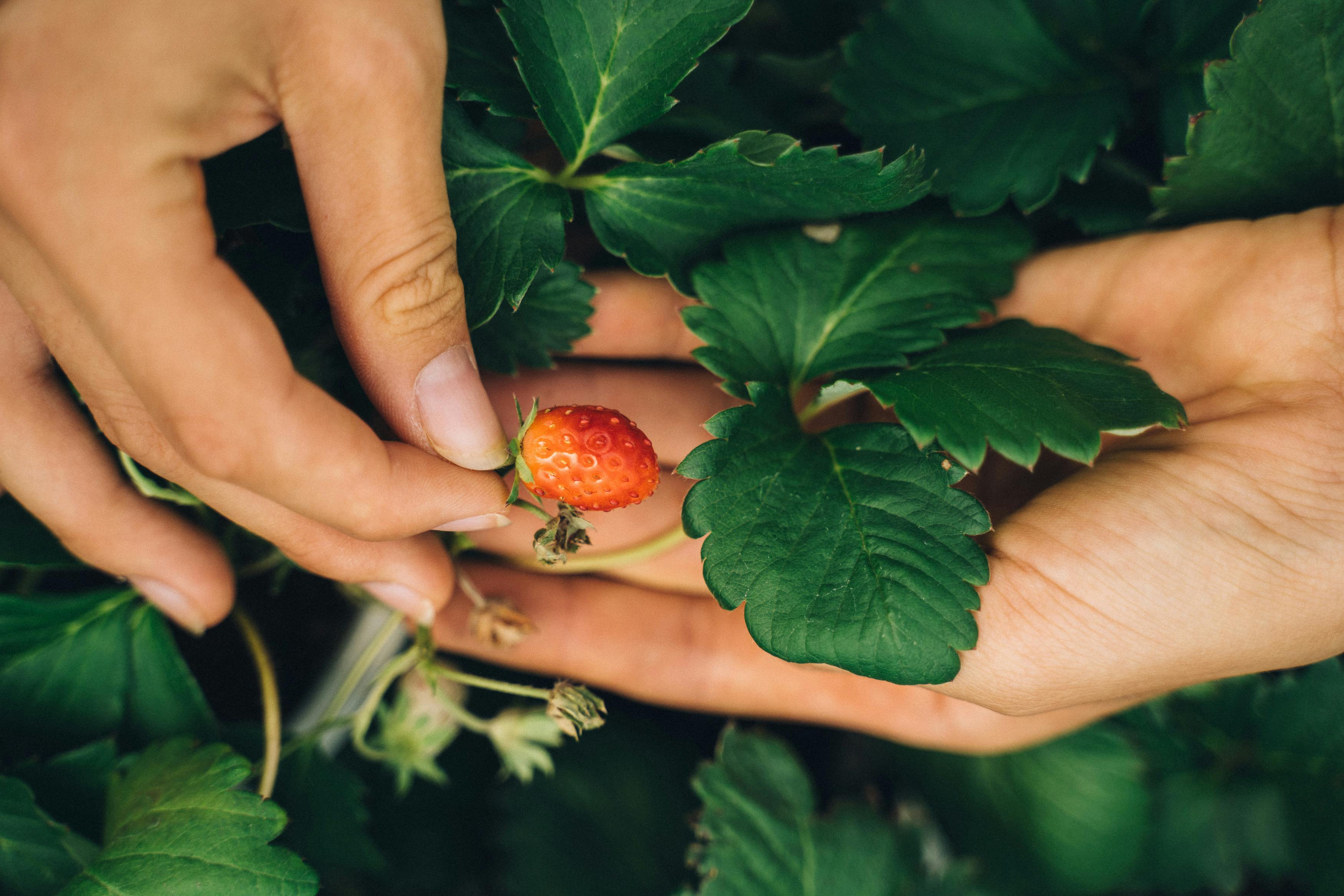Strawberry plants are a popular fruit crop to grow in the home garden, providing a tasty and nutritious addition to your meals. Unfortunately, strawberries don’t always thrive and there can be many reasons why your strawberry plant may be dying. In this article, we’ll discuss the common causes of strawberry plant death and how you can identify and address them.Common causes of dying strawberry plants include improper soil pH, inadequate water, nutrient deficiency, poor air circulation, disease, and pest infestation.
Identifying Symptoms of a Dying Strawberry Plant
Strawberry plants are relatively hardy, but can still succumb to disease and pests. If your strawberry plant is not performing as expected, it may be in distress. Identifying the symptoms of a dying strawberry plant can help you take action to save it. Some of the most common signs of a dying strawberry plant include discolored or wilted leaves, stunted growth, and poor fruit production.
Wilting and discoloration are two of the most obvious signs that there may be something wrong with your strawberry plant. Wilting occurs when the leaves become dry and limp due to lack of water. Discoloration can indicate that the plant is not receiving enough nutrients or is being affected by a pest or disease. If you notice any wilting or discoloration on your strawberry plants, check for signs of pests or diseases and take action to treat them if necessary.
Stunted growth is another sign that your strawberry plant may be in trouble. When a plant does not receive all the nutrients it needs for healthy growth, it may become stunted in size or produce fewer fruits than normal. Check the soil around your strawberry plants to make sure they are getting enough water and fertilizer.
Poor fruit production is another common symptom of a failing strawberry plant. If you have noticed fewer fruits than normal on your plants, this could be due to several factors including too much shade, lack of pollination, or disease. Check for signs of disease on the leaves and stems, and make sure that pollinators such as bees have access to your plants if necessary.
By familiarizing yourself with the symptoms of a dying strawberry plant, you will be able to take steps to save it before it’s too late. Check for signs such as wilting leaves, discoloration, stunted growth, and poor fruit production regularly so you can address any issues quickly before they become too severe.
What to Do if Your Strawberry Plant is Dying
It can be heartbreaking when your strawberry plant starts to die. Unfortunately, there are several causes for a dying strawberry plant, such as pests, disease, or improper care. To help ensure your strawberry plants are healthy and growing properly, you’ll need to identify the cause of the problem and take the necessary steps to correct it. Here are some tips on what to do if your strawberry plant is dying.
The first step is to check for pests or diseases that may be attacking the plant. Insects such as aphids, mites, and slugs can all cause damage to your plants. Diseases such as powdery mildew or leaf spot can also cause problems. If you find any of these pests or diseases on your plants, you’ll need to take action quickly in order to save them.
It’s also important to make sure that your plants have proper water and nutrients. Over-watering can lead to root rot and poor drainage can lead to fungal issues. Make sure that your plants are getting enough sunlight as well; too much shade can stunt their growth and prevent them from producing fruit. If you’re not sure how much water or sunlight your plants need, consult with a professional for advice on proper care for strawberries in your area.
Finally, make sure that you’re harvesting the strawberries regularly so that they don’t become stressed from overbearing fruit weight. Once any berries become overripe they should be removed immediately since rotting fruits will attract pests and disease more quickly than healthy fruits will. With a little bit of patience and effort, you should be able to get your strawberry plant back on track in no time!
Diagnosing the Disease Affecting a Strawberry Plant
Diagnosing the disease affecting a strawberry plant can be challenging, as there are many different diseases that can affect these plants. However, if growers know what to look for and take steps to prevent and identify diseases, they can help ensure their strawberries remain healthy. The first step in diagnosing a strawberry plant’s disease is to observe the symptoms of the plant. Look for signs of wilting or discoloration, yellowing or browning of leaves, spots on leaves or fruits, stunted growth, and other signs that may indicate something is wrong. Taking note of any visible symptoms can help point to what kind of disease may be present.
Next, it is important to consider environmental factors that could lead to disease in a strawberry plant. Poor soil conditions, excessive moisture in the soil, too much sun exposure, or lack of nutrients in the soil could all contribute to a plant’s decline. If any of these could be contributing factors, then growers should take steps to remedy them before attempting to diagnose a disease.
Finally, growers should examine their plants carefully for signs of pests or insects that may have caused damage to the plant. Insects such as aphids or thrips can cause damage by sucking sap from leaves and stems and leaving behind their excrement which leads to discoloration and fungal growth on the plants. If pests are suspected as being responsible for a strawberry plant’s decline then appropriate measures should be taken such as insecticidal sprays or traps.
By observing symptoms carefully and considering environmental factors that may contribute to disease in a strawberry plant, growers can take steps towards diagnosing what kind of problem they are dealing with and how best to treat it. With proper care and attention, they can help ensure their strawberries remain healthy and productive for years to come!
How to Prevent Your Strawberry Plant from Dying
Strawberry plants are a popular choice for home gardeners because of their delicious fruit and attractive foliage. Unfortunately, these plants are prone to dying if the conditions aren’t right. To ensure that your strawberry plant stays healthy and productive, you’ll need to take steps to prevent it from dying. Here are some tips on how to keep your strawberry plant alive:
1. Water Regularly: Strawberries need at least one inch of water per week, so make sure you water your plant consistently. If you live in an area with hot weather or low rainfall, you may even need to water your plant every day. You can also set up an irrigation system or use a drip irrigation system for easy and consistent watering.
2. Mulch: Mulching around your strawberry plant helps retain moisture and prevents weeds from competing with the roots for nutrients and water. Apply a two-inch layer of organic mulch such as straw, hay, or shredded leaves around the base of the plant.
3. Fertilize: Fertilizing your strawberry plants regularly helps them produce more fruit and stay healthy. Use a balanced fertilizer like 10-10-10 or one specifically formulated for strawberries according to package instructions.
4. Prune: Pruning helps keep your strawberry plant healthy by removing dead or damaged leaves and branches as well as encouraging new growth. It also helps promote air circulation which keeps fungal diseases at bay and allows more sunlight into the center of the plant, increasing yields.
5. Inspect for Pests: Inspecting your strawberry plants regularly is important in order to catch any pests before they become a major problem. Common pests include aphids, slugs, mites, caterpillars, snails, thrips, and nematodes which can all cause damage if left untreated.
By following these tips on how to prevent your strawberry plant from dying you can keep it healthy and productive all season long!

Proper Watering of a Strawberry Plant
Strawberry plants require consistent and proper watering to produce healthy, abundant fruit. It is important to water the soil deeply but not frequently. Generally, strawberry plants should receive about 1 to 2 inches of water per week. This amount should be adjusted based on the time of year and whether there has been any rain. During the spring, when new growth is actively occurring, it is best to err on the side of providing more water than less. During the summer months when temperatures are higher, it is best to provide less water as too much water can lead to root rot and disease.
When watering your strawberry plants, it is important to make sure you are providing even amounts of moisture throughout the entire area where your plant is growing. Water should be applied slowly so that it has time to soak into the soil rather than running off or evaporating quickly in hot weather. If possible, using a soaker hose or drip irrigation system can help ensure that your strawberry plant receives an even amount of moisture throughout its root zone.
When watering your strawberry plant, make sure not to wet the leaves as this can lead to disease and fungal issues. Additionally, do not let your strawberry plant sit in standing water for extended periods of time as this can also cause root rot and other problems. Mulching around your strawberry plant can help keep moisture levels consistent throughout the day while helping reduce weeds and retain heat during cold nights in spring and fall months.
In summary, proper watering of a strawberry plant is essential for healthy growth and abundant harvest. Be sure to water deeply but not frequently and provide an even amount of moisture throughout its root zone using either a soaker hose or drip irrigation system if possible. Additionally, avoid wetting the leaves or letting it sit in standing water for long periods of time as this can cause root rot and other issues with your plant’s health.
The Right Amount of Sunlight for a Strawberry Plant
Strawberries are one of the most popular fruits in the world. They are also very easy to grow in most climates, as long as they have the right amount of sunlight. The ideal amount of sunlight for a strawberry plant is six to eight hours per day, with maximum exposure during the middle part of the day when the sun is strongest.
Strawberry plants should be placed in an area that receives full sun during the morning hours and partial shade during the afternoon hours. This will help keep them from getting too much direct sunlight and wilting in high temperatures. If you live in an area with very hot summers, it may be best to provide some shade protection for your strawberry plants.
It is important to note that too much or too little sunlight can be detrimental to strawberry plants. Too little sunlight can cause weak growth and misshapen or smaller fruit, while too much can cause leaves to yellow and scorch, reducing yields and fruit quality. Therefore, it is important to carefully monitor your plants’ exposure to sunlight and adjust accordingly if needed.
In addition to providing adequate sunlight, strawberry plants also need plenty of water and fertilizer for optimal growth and production. As with any other vegetable or fruit crop, regular watering and fertilizing are essential for healthy strawberry plants that produce an abundance of sweet, juicy berries.
Overall, strawberries are quite easy to grow and require relatively low maintenance compared with other fruit crops. As long as they receive six to eight hours of direct sunlight each day along with adequate water and fertilizer, they will thrive in most climates. By providing your strawberry plant with the right amount of sunlight each day, you can enjoy a healthy harvest all season long!
Understanding Soil Requirements for a Healthy Strawberry Plant
Growing strawberries requires the right soil conditions to ensure a healthy and plentiful harvest. The most important factor for growing strawberries is the soil’s pH level, which should be between 5.5 and 6.5. A slightly acidic soil is best for strawberry plants because it helps the plants absorb the nutrients they need from the soil more efficiently. Additionally, soil should be well-drained, rich in organic matter, and high in nitrogen and potassium to promote healthy growth and development.
It’s also important to test your soil regularly to make sure that it has the right pH balance and nutrient levels. If your soil is too alkaline, you can add sulfur or iron sulfate to reduce its pH level or amend it with organic matter such as compost or manure. On the other hand, if your soil is too acidic, you can add lime or wood ash to raise its pH level.
When planting strawberry plants, it’s important to dig a hole that’s at least twice as wide and deep as the root ball of the plant. The hole should be filled with loose soil mixed with compost or manure so that there are plenty of nutrients for the plant to absorb. Additionally, it’s important to ensure that each plant is spaced at least 12 inches apart from one another so that there is enough room for them to grow without being crowded by other plants.
It’s also important to water your strawberry plants regularly throughout their growing season and mulch around them with straw or shredded bark after they have been planted. Mulching helps conserve water in dry climates and prevents weeds from competing with your plants for nutrients and water. Additionally, regular fertilizing throughout their growing season will help promote healthy growth and development of your strawberry plants while helping them produce abundant yields of delicious fruit!

Conclusion
It is important to identify the cause of your strawberry plant dying in order to determine the best course of action. Common causes of dying strawberry plants can include disease, pests, environmental factors such as poor soil and lack of sunlight, and incorrect care. If you are able to identify the cause of your strawberry plant dying, then you can take steps to correct it. Proper maintenance and care of your strawberry plant is essential for its health and growth.
It is also important to remember that strawberry plants do not live forever, so it is possible that your plant may be at the end of its life cycle. If this is the case, then you may need to replace it with a new plant in order to get a good harvest. Taking good care of your strawberry plants now will help ensure a bountiful harvest for years to come.



